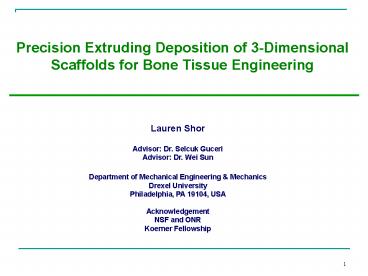Slicing Algorithm - PowerPoint PPT Presentation
1 / 21
Title: Slicing Algorithm
1
Precision Extruding Deposition of 3-Dimensional
Scaffolds for Bone Tissue Engineering
Lauren Shor Advisor Dr. Selcuk Guceri Advisor
Dr. Wei Sun Department of Mechanical Engineering
Mechanics Drexel University Philadelphia, PA
19104, USA Acknowledgement NSF and ONR Koerner
Fellowship
2
Introduction-Tissues Engineering
Scaffold (with cells)
3
Introduction-Mechanical Properties of Human Tissue
YANG ET AL. Biomaterials, 23, 2119-2126, (2002).
4
Scaffold Design
- The regeneration of specific tissues is dependent
on the porosity and pore size of the supporting
3D scaffold. - A large surface area favors cell attachment and
growth - A large pore volume is to accommodate and
deliver a sufficient number of cells - High porosity is for the easy diffusion of
nutrients, transport and for vascularization. - Interconnectivity
100-350 microns for regeneration of bone, 500
microns for fibrovascular tissues for rapid
vascularization and survival of cells
5
Introduction-Process of Scaffold Manufacturing
6
Freeform Fabrication by Precision Extrusion
Deposition
Positioning controller
Mini-Extruder Controller
Mini Heaters
7
System Control Software
8
Introduction-Materials
- Hydroxyapatite
- Ceramic
- Biocompatible
- Osteoconductive
- Drawbacks
- Brittle
- Not easily processed
- Applications
- Used in dental and orthopedic surgery as fillers
for bone defects - Coatings on metallic implants to improve implant
integration in host bone.
- Polycaprolactone
- Polymer
- Biocompatible
- Biodegradable
- Low melt temperature
- Drawbacks
- Long degradation rate
- Not bioactive
Ca10(PO4)6(OH)2
9
Pattern Specification
- Basic process parameters
- Materials (melting point)
- Driven and speed
- Temperature
- Diameter of Nozzle
- Deposition speed
10
SEM Images of Scaffold
0/120 layout pattern
0/90 layout pattern
11
Interconnectivity
12
Biological Characterization In Vivo
To determine if osteoblast-seeded PCL scaffolds
will induce osteogenesis in vivo.
5 million cells/implant
Implants removed after 4, 6 and 8 week time
periods
Scaffolds implanted subcutaneously in nude mice
Fetal bovine osteoblast cells harvested and
cultured
Fixation, sectioning and histological analysis of
explants
13
In Vivo Study Results Histological
Dr. H. An, MUSC, 8 weeks
14
Fabrication of Composite PCL/HA Scaffold
- PCL/HA Scaffolds
- Varying Parameters
- Pore size
- Porosity
- HA Concentration, 15, 33
- and 45
15
HA/PCL Results Bulk Material
SEM imaging using Back Scatter Detector
PCL/HA 45
PCL/HA 45
16
HA/PCL Results - Scaffold
SEM imaging using Back Scatter Detector
PCL/ HA Scaffold (33)
17
Biological Characterization In Vitro
Dead at 4x
Live at 4x
Shows complete coverage of the entire scaffold
surface after only 4 days
18
Biological Characterization In Vitro
Live At 10x
Dead At 10x
Live At 20x
19
Complex Geometries
20
Summary and Conclusion
- Construction of PCL and composite scaffolds using
a novel deposition system, was achieved. - The preliminary results show a promise of using
the developed deposition system for fabrication
of tissue scaffolds and constructs. - SEM and Micro-CT analyses showed good correlation
between designed construct and fabricated part - Cellular biological studies and cell
survivability studies were conducted and showed
biocompatibility and promise for application in
orthopeadic tissue engineering
21
Questions?































